On Stockholm!
By the beginning of 1809, Sweden’s position was hopeless. The Swedish army was not able to win Finland. The English fleet was ready to support Sweden, but it was clear that the British could not undertake anything serious. They could attack and sink individual ships, seize merchant ships, rob unprotected settlements on the coast, but no more. Britain was not going to send troops to Sweden or Finland. Britain could not organize a blow to St. Petersburg, following the example of Copenhagen, it was dangerous to go there.
Nevertheless, the stubborn Swedish king Gustav IV Adolf, despite the discontent of the environment, which demanded the conclusion of peace, decided to continue the war. In this case, the king still considered the main task of the fight against Denmark. The most efficient Swedish troops were left in the south of the country - in Scania and on the border with Norway, although no particular threat from the Danes in 1809 was foreseen. For the defense of the Swedish capital, 5 thousand soldiers were recruited. In the area of Torneo 7-thousand was concentrated. body of Grippenberg.
In Åland, 6 of thousands of regular troops and 4 of thousands of militias were assembled. The defense of the Aland Islands was led by General Debeln. Fearing that Russian troops would bypass the islands from the south, Debeln evacuated the entire population of the southern islands and burned down and devastated all the villages that remained there. Debeln gathered all his forces on the Big Aland, cut off all the ways with chasers, arranged artillery batteries in the most important coastal points, and a redoubt on the most western island of Ecker.
Emperor Alexander was not pleased with Count Buksgevden and in early December 1808, General Infantry General Knorring took the place of Bucksgevden. In February, 1809 was replaced by corps command. Instead of Wittgenstein, the southern corps was headed by Bagration, the central corps instead of Golitsyn was headed by Barclay de Tolly, and the northern corps, instead of Tuchkov, by Shuvalov.
The campaign plan for 1809 was drawn up tactically and strategically correctly. The Russian army was increased to 48 thousand bayonets and sabers. The plan called for the occupation of the Aland Islands by Bagration's troops from Abo, followed by the withdrawal to the Swedish coast, the offensive of Barclay de Tolly’s corps from Vasa across the Quarken strait to Umeå, with the simultaneous advance of the corps of General P.A.
Knorring, considering this plan impracticable, delayed its implementation until mid-February. Alexander I, extremely dissatisfied with this, sent the Minister of War to Finland, Count Arakcheev, who, arriving on February 20 in Abo, insisted on the speediest fulfillment of the highest will. Russian army began to move.
Russian offensive
The onset of the northern corps of Shuvalov. 6 (18) March 1809. General Shuvalov notified the commander of the northern grouping of the Swedish army of Grippenberg about the termination of the truce. The Swedes concentrated their troops near the city of Kalix, 10 versts west of Tornio (Tornio) and decided to give battle.
On March 6, the Russians crossed the Kemi River and moved west along the seashore. The Swedish avant-garde, which was located in the city of Tornio, did not accept the battle and retreated, leaving the sick soldiers. The offensive took place in difficult environmental conditions: Russian soldiers made marches 30-35 versts in thirty-degree frost. Approaching Kalix, Shuvalov suggested that the enemy capitulate, but the Swedes refused. Then the main forces of the corps began an offensive in the forehead, and the column of General Alekseev went around the ice and cut off the Swedish retreat. The Swedes were forced to ask for a truce. Shuvalov did not agree to the truce and demanded total surrender, giving the term 4 an hour. The Swedes were forced to capitulate. 13 March 1809. Grippenberg signed the act of surrender. Its 7-th. body folded weapon and was dismissed to their homes on parole not to fight this war anymore. Finns went to Finland, the Swedes - to Sweden. The 22 guns and 12 banners became the trophies of the Russian army. All Swedish stocks up to the city of Umeå should have been intact for the Russian army.
Thus, the northern building Shuvalov successfully completed its task. The Russian army broke off the last link of Finland with Sweden. Count Shuvalov stopped, receiving news of a truce concluded on the Alands.
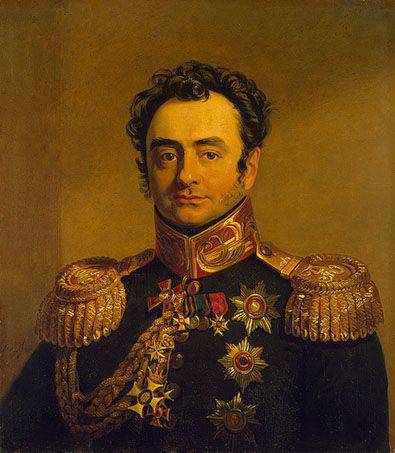
General Pavel Andreevich Shuvalov
The onset of the central building of Barclay de Tolly. Barclay's corps was supposed to have 8 thousand soldiers, but most of the troops stayed on the transition to Vasya. Barclay, fearing that the ice would soon begin to melt, ordered the attack to begin with the available forces. As a result, his unit had just 3200 people with 6 guns (6 infantry battalions and 250 Cossacks). March 6 troops read the order, in which Barclay de Tolii, not concealing the upcoming difficulties, expressed confidence that "for the Russian soldiers the impossible does not exist."
On the same day, the first battalion went forward to lay a path. For reconnaissance and capture of advanced Swedish posts, the flying squadron of Kiselyov — the 40 musketeers of the Polotsk Regiment on carts and the 50 Cossacks — began to move. After the 13-hour crossing, the Kiselev detachment approached Grossgrund Island, where they captured the Swedish post. On March 7, all of Barclay’s existing forces crossed over to Vals-Erar island, and on March 8 marched in two columns through Kvarken. In the right column was Colonel Filisov with the Polotsk regiment and one hundred Cossacks on the island of Holme, on the left - Count Berg with the rest of the troops on the island of Gadden. In the same column was Barclay. Artillery with a battalion of Life Grenadier followed separately for the right column.
Like the troops of Shuvalov, the soldiers of Barclay overcame great difficulties. The soldiers went knee-deep in the snow, constantly walking around or climbing over ice blocks. The frosty weather and strong north wind did not give an opportunity to rest. By evening, the troops reached the islands and settled down to rest. Early in the morning the troops continued to move. Column Filisova joined the battle with three enemy companies, which settled on the island of Holme. Swedes went around and they retreated. Fearing for the backward artillery, Filisov continued to move only the next morning.
Meanwhile, the left column was moving to the mouth of the Umea River. After a heavy eighteen-hour march, the column was 6 versts from Umeå. The soldiers were extremely exhausted. The troops had to spend the night again on the ice. The soldiers were lucky to find two merchant ships frozen in the ice nearby. They were dismantled and lit fires. At this time, the Cossack patrols reached the city of Umeå and started a shootout. A panic began in the city: “The Russians are coming!” Commandant Umea, Count Kronstedt, was prostrated: there was shooting in the city, there was a sea of lights on the ice.
On the morning of March 10, when Barclay's vanguard began a battle, and the entire column was already entering the mainland, a Swedish envoy arrived and announced the impending truce. General Kronstedt surrendered Umeå to the Russian troops with all the supplies and withdrew his troops 200 versts to the city of Gernesand. Thus, the offensive corps Barclay also ended in complete success. When the troops of Shuvalov approached, the Russian army could continue the offensive further.
Having occupied Umeå, Barclay de Tolly made all the orders to establish himself in the city and was preparing to wait for the approach of Shuvalov’s troops. On the evening of March 11, news of a truce was received along with an unexpected order to return troops to Vasu. Barclay was hard to carry out this order, since the withdrawal was like a retreat. The main forces moved back 15 March, and the rearguard - 17 March. Despite the severe frost, the reverse movement was not so difficult, since the road was already paved. In addition, carts for the sick and wounded were taken from the Swedes, they received warm clothes and blankets and various equipment from the warehouses.
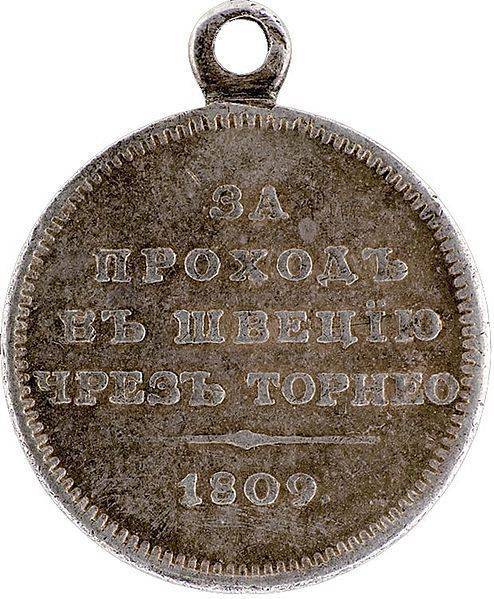
Medal "For the passage to Sweden through Tornio"
The onset of the southern corps of Bagration. Bagration corps had to solve the main task, therefore it was the most powerful - 15,5 thousand infantry and 2 thousand cavalry, 20 guns. The corps had good material support. The troops were well supplied with warm clothing - sheepskin coats, warm caps and felt boots. For the troops moving sleigh loaded with provisions, vodka and firewood. At the end of February 1809, the corps of Bagration from the Abo district moved to the starting point on Kumlinge Island. The military minister was joined by the Minister of War Arakcheev, the commander-in-chief of Knorring and the Russian envoy to Sweden, Alopeus, who had authority over diplomatic negotiations with Stockholm.
3 (15) in March, Bagration's corps launched an offensive with 4 columns from the front from the east, and 5-I column bypassed the Aland Islands from the south. The left avant-garde column commanded Kulnev, right - Shepelev. The advanced posts of the Swedes left small islands and left to the west. In the evening of March 3, the first four columns occupied the island of Varde, located in front of the Big Aland, and the fifth column passed through Sottunga to the Bene island, where it collided with the enemy’s rear guard. Cossacks attacked the Swedes, and Kulnev went around, it forced the enemy to retreat. The head of the Aland Swedish Corps faced the threat of complete defeat, and having received the news of the coup d'état in Stockholm, began to withdraw troops.
A coup really happened in Stockholm. The war was unpopular among the guard and aristocracy. In the winter of 1808-1809. opposition groups began to develop a plan to overthrow Gustav Adolf and eliminate absolutism. The plot involved senior officers and officials. They were led by Adjutant General Adlerkreutz, Commander of the Western Army, General Adlersparre and an official from the Judiciary of Erta. Promising the Danish commander, Prince Christian Augustenburg, the title of heir to the Swedish throne, Adlersparre entered into an agreement with him on a temporary ceasefire and moved with part of the troops to Stockholm. March 1 (13), he and the guards broke into the king’s chambers and took him into custody. Uncle Gustav, the Duke of Südermanland, named Charles XIII, who commanded the Swedish during the Russo-Swedish War of 1788-1790, was chosen the new king. fleet. However, by this time he had already fallen into dementia and had no real influence on politics. In fact, power was in the hands of the aristocracy.
The Swedish capital was in danger of falling. Russian troops left before it all 5-6 transitions. Therefore, the new Swedish government appealed to the Russians for a truce. First, Colonel Lagerbrinn was sent to meet our army. But Bagration did not begin to negotiate with him and sent in a train to Arakcheev and Knorring. Bagration himself ordered the troops to continue the offensive. Two days later, the entire Åland archipelago was occupied without a fight. The cavalry of the avant-garde Kulneva overtook the rear guard of the Swedish army. The Cossacks Isayev surrounded one column, repulsed two guns and captured the 144 man. Then they caught up with the second square and beat off two more guns. The Grodno Hussars surrounded the battalion of the Südermanladsky regiment (14 officers and 442 of the lower ranks headed by the commander) and after a short exchange of fire they were forced to capitulate. As a result, Kulnev captured more prisoners than he had in the squad, not counting the large number of trophies. Russian troops captured more than 2 thousands of prisoners, 32 guns, over 150 ships and vessels.
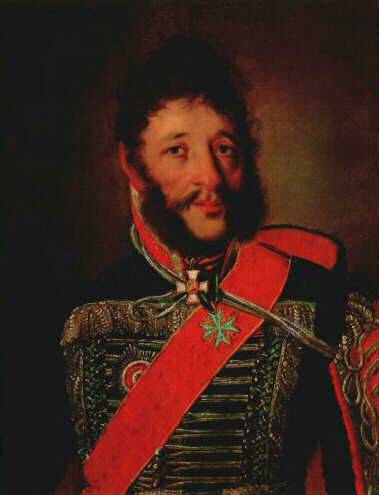
Hero of the Russian-Swedish war Yakov Petrovich Kulnev
4 (16) in March, Major General Debeln arrived in Bagration's corps asking for a truce. He negotiated with Arakcheev and Knorring. Arakcheev initially did not agree to a truce, citing the fact that the purpose of Emperor Alexander is to sign peace in Stockholm. Then Arakcheev sent armistice terms to the Swedes: 1) Sweden was supposed to cede Finland forever within the borders to the Kalix River, the Aland Islands, the sea border between the two powers would have to pass along the Gulf of Bothnia; 2) Sweden will renounce its alliance with England and enter into an alliance with Russia; 3) Russia can support Sweden with troops if England lands troops against Sweden.
However, Arakcheev made a mistake, not bringing the case to the end. The world had to be dictated on the Swedish coast. There was very little left - the advance guard of the Russian troops led by Major General Kulnev 7 (19) in March reached the shores of Sweden, captured Grisselgam, creating an immediate threat to Stockholm. Kulnev scattered his squad so skillfully that it seemed much stronger to the Swedes than it was in reality. The appearance of a small detachment Kulneva caused great fright in Stockholm.
Arakcheev and Knorring, to show the sincerity of our aspirations for peace, ordered the troops of Bagration to return to Abo. Barclay de Tolly’s squad, which had already crossed Quark’s bay, was also recalled. In fact, Debeln deliberately misled the Russian generals to pull time and save Stockholm.
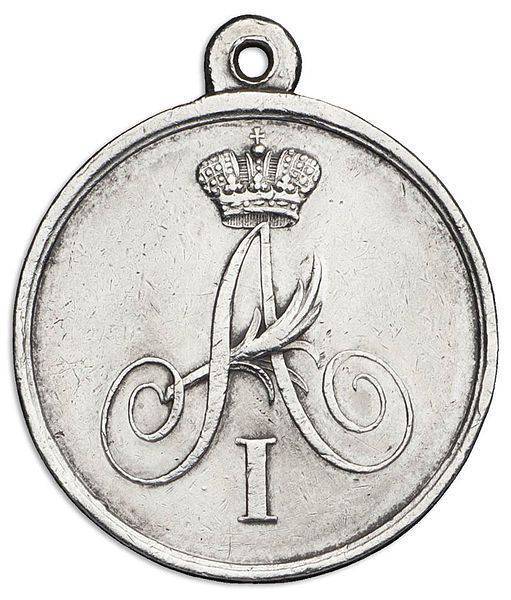
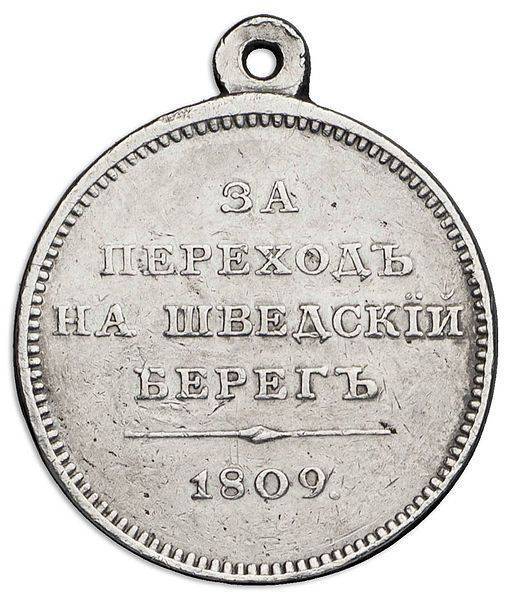
Medal "For the transition to the Swedish coast"
The continuation of the war
In early April, 1809, when Russian troops left the Swedish territory, and the melting of the ice made it impossible to throw a new throw at Stockholm, the Swedish government began to put unacceptable conditions for peace to St. Petersburg. Alexander I 19 (31) March canceled the truce. Knorring was replaced by Barclay de Tolly. The Shuvalov Corps, which was ceded to Northern Finland under the terms of the armistice, was ordered to re-enter Sweden.
18 (30) April 5-th. Shuvalov's corps made from Torneo. 26 April Shuvalov forced march went to Piteo and, learning about the concentration of enemy troops in Skellefteo, went there. Before reaching 10 versts, he sent the 2 Infantry Regiment (Revelsky, Sevsky, Mogilevsky and 4 Egersky) with artillery and a small number of Cossacks on the ice that barely strayed off the coast in May under General Alekseyev’s command. already freed of ice) to the rear of the enemy. Himself with 3 shelves (Nizovsky, Azov, Kaluga and 5-yegersky) continued to move along the coast.
The decision was extremely risky, but it justified itself. Furumak's detachment was taken by surprise, trapped in ticks and capitulated. About 700 people were taken prisoner, 22 guns and 4 flags became Russian trophies. At that time, Debeln was appointed commander of the Swedish army in the North. Arriving at Umeå, he resorted to the same trick. Debel asked Count Shuvalov to stop the bloodshed, aimless because of the close conclusion of peace. Shuvalov stopped the movement and sent a letter to Debeln Barclay.
While negotiations were underway, the Swedes quickly took away the transports with all the supplies and property. Finally, when 14 in May, Shuvalov, without waiting for a response from the commander-in-chief, concluded a preliminary convention with the Swedes on the transfer of the Umea to the Russians. Barclay de Tolly rejected the truce and ordered Shuvalov to "threaten the enemy with active war in Sweden itself." But this order was late, the Swedes took out stocks and entrenched in new positions. Shuvalov, due to illness, has already passed the corps to General Alekseev. The latter advanced forward troops to the southern borders of Westbothnia, taking a number of points on the coast of the Gulf of Bothnia.
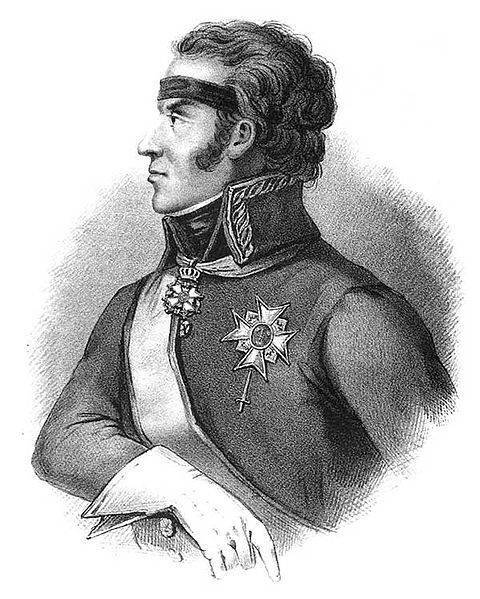
Swedish commander Georg Karl von Debeln
Alekseev's building was in a dangerous position, since it was located in 600 km from the main base in Uleaborg. Sea supply was interrupted, the coastal flank was threatened by the Swedish fleet. There was a lack of food. The region was exhausted by the war, and all the food supplies were taken by Debeln.
When the Riksdag meeting in Stockholm proclaimed the Duke of Südermanland as king Karl XIII, the new government, wishing to restore the prestige of the kingdom, was inclined to the proposal of General Wrede to continue the war and oust the Russians from Ostrobothnia (central Finland). The Swedish command decided to take advantage of the inaction of the Russian sailing fleet, which almost all the war was defended in Kronstadt and, taking advantage of the superiority of the sea, to defeat Alekseev's corps.
Alekseev also understood that the situation was dangerous, he brought together certain parts of the corps and pulled the vanguard located on the Era River closer to Umeå. In June, the Ume-Elv River spilled from the melting snow on the Lapland Mountains and damaged the bridge at Umeå between the vanguard and the main forces of the Alekseev detachment. Learning about the damage to the bridge and believing it possible to break the vanguard before the arrival of reinforcements from Umeå, Sandels decided to attack him and began to prepare for the performance. He had 3 thousand soldiers and support from the sea of 4 frigates and a rowing fleet.
However, General Alekseev received news of the attack of the enemy and decided to counterattack the Swedes. He corrected the bridge and ordered General Kazachkovsky to attack the enemy with the Sevsky, Kaluga, Nizovsky, 24 and 26 infantry regiments of rangers, half of the squadron of Mitavy dragoons, fifty Cossacks and 4 guns. Sandels stood under Hörnefors, behind the River Gjorn, sending forward the small vanguard of Major Ernroth. In the evening of June 21, the advanced units of the Swedes were defeated.
Not several kilometers from Hörnefors, Kazachkovsky divided his detachment into two parts: with the regiments of Sevsky, Kaluzhsky and 24 jaeger he went a long way, and Lieutenant Colonel Karpenko sent the 26 th Jäger regiment to the right, into the forest, bypassing the left flank of the Swedes . In reserve was left Nizovsky regiment. The execution of this plan was favored by a thick fog and extreme carelessness of the Swedes, who did not expect the attack of the Russian troops. The attack was unexpected for the Swedes; knocking out the outposts, the Russians began to push the enemy into disarray and confusion. The attempt to arrange the troops behind the bridge failed, and he began to withdraw them, and to cover the retreat, he appointed a battalion of the famous partisan Dunker, who completed the task, but died in this battle. In the following days, the fighting continued, but the Swedes repulsed Russian attacks. Interestingly, after this success, Alexander removed Alekseev from the command of the corps and appointed Kamensky instead.
Battle of Hörnefors. Source: Mikhailovsky-Danilevsky A. I. Description of the Finnish War on the Dry Way and at Sea in 1808 and 1809
To be continued ...
- Alexander Samsonov
- Russian-Swedish War 1808 — 1809
How Russia defeated Sweden and annexed Finland
Siege of Sveaborg and the capture of Finland
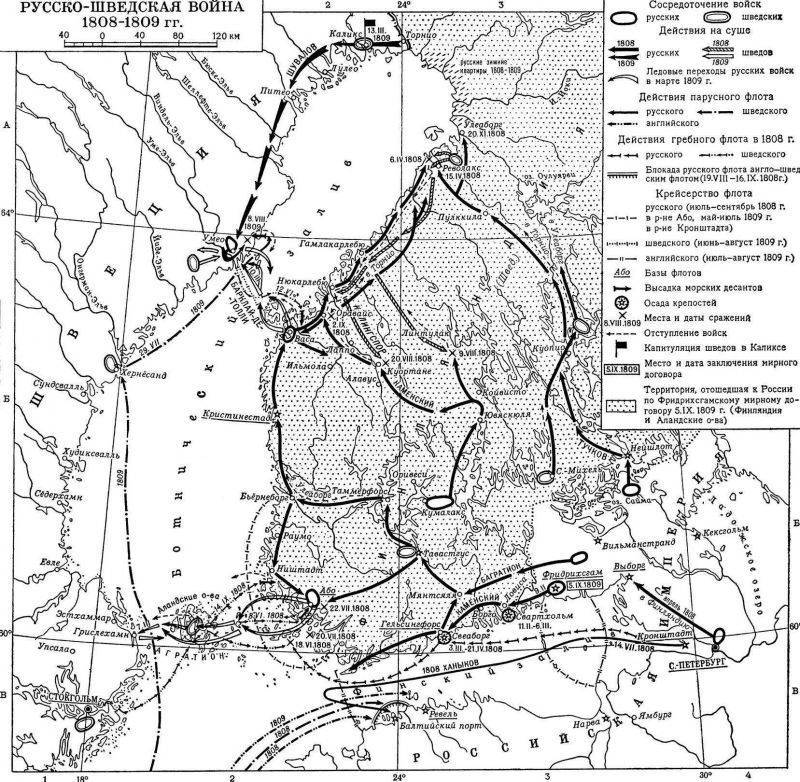
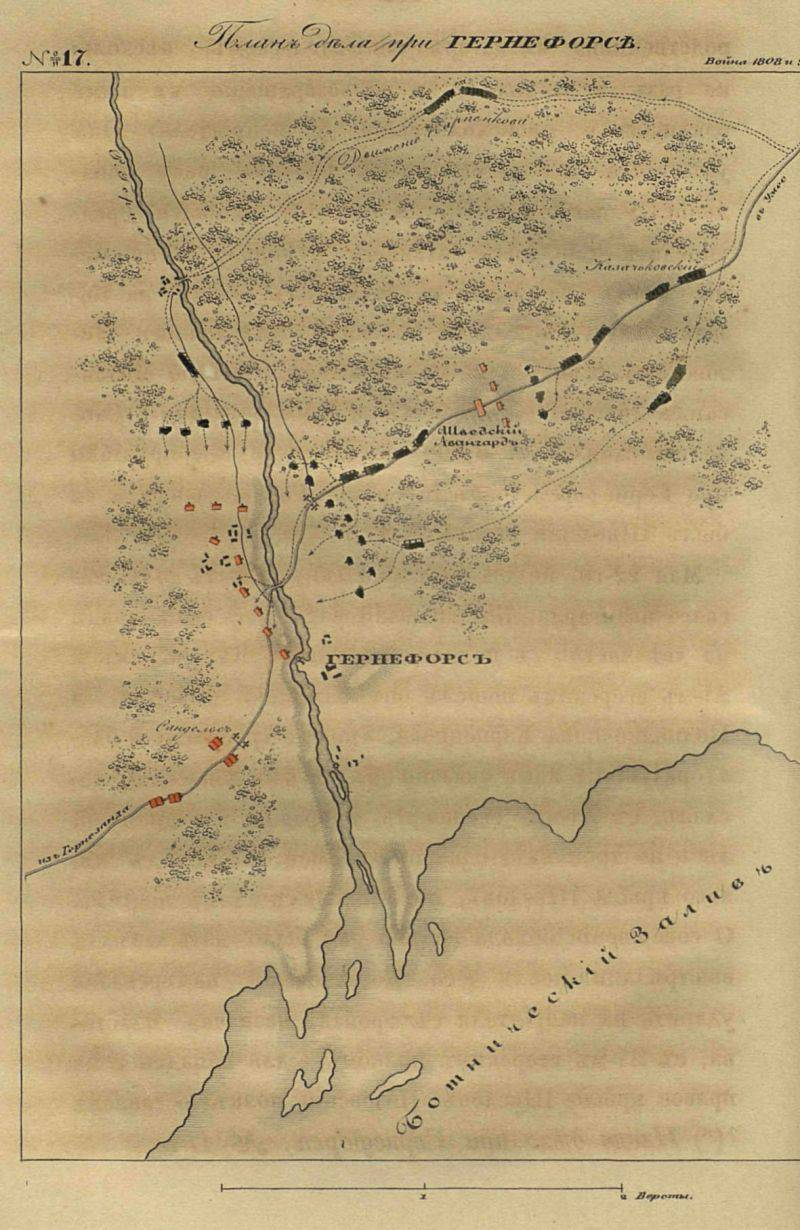
Information